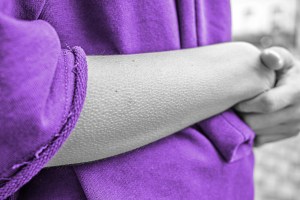
Poppin’ Fresh, the Pillsbury Doughboy
The Pillsbury Doughboy is one of the most enduring brand mascots of all time. Created by a Chicago ad copywriter in 1965 and rendered via stop-motion claymation (which required a stunning 24 shots per second of video), the mascot emerged from a roll of dough to declare: “I’m Poppin’ Fresh, the Pillsbury Doughboy!” Within three years, the character had an 87% recognition factor among shoppers.
Over the years, the Doughboy — who has famously represented 50 Pillsbury products across more than 600 commercials and ads — has continued to grow in popularity. He receives fan mail and requests for autographed photos, and at one point in the 1970s, Pillsbury fans were able to collect Poppin’ and the rest of the Fresh family — including his wife Poppie and kids Popper and Bun-Bun — when a series of popular vinyl dolls were released. Poppin’ Fresh, who has been rendered in CGI since 1992, is still out there buttering the public’s biscuits after 55 years: He made his debut in the Macy’s Thanksgiving Day Parade in 2009 and has been a fan favorite ever since.

The Geico Gecko
The Geico Gecko was born of a Screen Actors Guild strike that prevented the hiring of live actors. After an initial appearance in 1998, the mascot officially debuted during the beginning of the 1999 television season. Those early commercials pleaded with viewers to recognize the difference between the car insurance brand and, well, a gecko. In fact, the whole campaign was inspired by individuals commonly misspelling or mispronouncing “Geico.”
Back then, the Geico Gecko had a posh British accent and was voiced by Frasier’s Kelsey Grammer. As years passed, a more casual Cockney accent was adopted to color the little green mascot as friendlier and more approachable — the spokeslizard next door, if you will. The Gecko has appeared in hundreds of commercials for the brand and even released a book, You’re Only Human: A Guide to Life, in 2013.

Kool-Aid Man
Back in 1954, Kool-Aid Man was known as Pitcher Man. Reportedly inspired by an ad agency’s art director who would watch his son draw smiley faces on frosty windows, the grinning pitcher promoted the ability to make two quarts of refreshing Kool-Aid from one tiny package. In 1974, the character got a revamp — he was renamed Kool-Aid Man, given arms and legs, and debuted in the brand’s first television commercials. By the 1980s, Kool-Aid Man and his “Oh yeah!” slogan were famously bursting through walls with refreshing pitchers of the soft drink for thirsty kids. His pop culture domination was solidified with appearances in video games, as well as a short-lived comic book series called Kool-Aid Komics. More recently, Kool-Aid Man has appeared in both The Simpsons and Family Guy.
More Interesting Reads

Mr. Clean
If you visit Procter & Gamble’s Mr. Clean website, you’ll find an origin story involving a mysterious bald baby industriously cleaning a farmer’s front porch. The farmer and his wife thought “he was the cutest, cleanest baby [they] had ever seen,” and so they adopted him. The hardworking baby grew big and strong and traveled the world to help clean messes. His travels inspired a book, The Encleanapedia, which may or may not only exist as a promotional item at corporate press events.
Mr. Clean, the product, was developed as a less caustic cleaning agent for boats. When Procter & Gamble added the brand to its stable, Mr. Clean the mascot was born. Created by an ad agency in 1957, the muscular, tan, famously bald, genie-esque character in a tight white tee was reportedly modeled after a retired Navy sailor from Florida. The first animated commercial debuted in 1958, and within six months, Mr. Clean was the best-selling cleaning product in America.

Mr. Peanut
Mr. Peanut’s proper given name is Bartholomew Richard Fitzgerald-Smythe, which perhaps explains his regal top hat paired with a monocle and spats. A classic mascot, Mr. Peanut first represented Planters nuts in 1916, when a Virginian schoolboy named Antonio Gentile won a design contest with his anthropomorphic peanut drawings.
Mr. Peanut’s first Times Square billboard appeared in 1937, and 60 years later, in 1997, he made another New York City splash with his first Macy’s Thanksgiving Day Parade appearance. Animated television commercials featuring the dapper legume began airing in the 1950s, but Mr. Peanut didn’t speak until 2010, when he was voiced by Robert Downey Jr. In a surprising turn of events, however, the 2020 Planters Super Bowl commercial killed off Mr. Peanut and replaced him with Peanut Jr., a hip kid nut in a baseball cap.

The Michelin Man
One of the world’s earliest and most enduring mascots, Bibendum — better known as the Michelin Man — was introduced way back in the Victorian era. Large and puffy, the iconic mascot is said to have been inspired by a pile of tires that looked a bit like a man. A cartoonist in 1898 ran with the idea and created the Michelin Man, who wore pince-nez glasses on a chain, held a glass full of beer, and smoked a cigar. In later ads, his goblet was filled with bits of broken glass and nails, which, alongside a slogan that referred to “drinking up” the road, boasted the tire brand’s ability to overcome hazardous driving conditions.
It might seem odd for a tire mascot to be stark white, but the rubber used in tires was a milky white until around 1917, when companies began adding carbon black to the formula to increase its durability. Thus, Michelin Man has always been white — but his appearance has morphed in other ways over the years. The earliest versions were considerably less friendly looking and more mummy-like, and were usually based on slimmer bicycle tires. In the 1920s, he became a bit more athletic-looking. (That’s around when he quit smoking.) And in 1998, his 100th anniversary saw the introduction of an even slimmer Bibendum, inspired by the lower-profile tires of modern cars. Currently, a CGI Michelin Man is often accompanied by his dog Bubbles.

Smokey Bear
Smokey Bear was born from an effort to curb forest fires in the 1940s, when many firefighters were off fighting World War II. An initial campaign distributed fire prevention posters, including a series featuring characters from the hit Disney film Bambi. In 1944, an official mascot was created: a bear in blue jeans and a campaign hat named after New York Fire Department hero “Smokey” Joe Martin.
In 1950, a bear cub injured in a forest fire in New Mexico became the real-world Smokey. He lived at the National Zoo in Washington, D.C., for 26 years, during which time he received an estimated 13,000 fan letters a week. Meanwhile, Smokey the cartoon mascot had begun appearing on radio and television programs, in comic strips, in a line of toys, and even in a Little Golden Book. In 1952, to capitalize on the success of Smokey, Congress passed the Smokey Bear Act, which removed the fire-prevention bear from the public domain and ensured any royalties on Smokey tie-ins would go toward fire-prevention education. In 2013, for Smokey’s 70th birthday, the Forest Service released a social media-heavy campaign centered around the “Smokey Bear Hug.” It focused on more unusual causes of wildfires in all places, not just forests.

The Energizer Bunny
In the Energizer Bunny’s first commercial, he marched onto the screen, decked out in sunglasses and flip flops and beating his big bass drum, and outlasted the rows and rows of snare drum-playing pink bunnies. But why pink bunnies? Well, the 1988 ad was an attack on a long-running commercial by a top competitor. Duracell had used a pink bunny with a snare drum for 15 years, but in 1973, with their trademark on musically gifted rabbits expiring, Energizer swept in.
The mascot worked well for Energizer, and so began decades of memorable ads featuring their hip, high-stamina cottontail. Earlier commercials appeared to be selling fictional restaurant brands, phone companies, or sinus medications until the relentless Energizer Bunny showed up and a voiceover touted the company’s slogan. Now, 30-plus years later, he’s still going and going and going …










